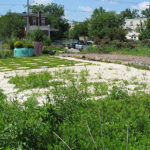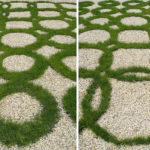Featured in Landscape Architecture Magazine
| Project | Self-initiated research project exploring geotextile customization |
| Location | Philadelphia, PA |
| Date | Design/ constructed 2009 |
| Collaborators | The Redevelopment Authority of the City of Philadelphia (RDA), the Urban Tree Connection |
Our ‘Not’ prototypes are part of the “Incremental Infrastructure” series. These installations addressed the issue of maintenance in vacant sites.
This project renders visible those materials that typically remain unseen. We use the untapped design potential of low-cost engineering substrates as a means for developing new techniques of surface control and display. Customized geotextiles hold great potential for configuring new relationships between organic and inorganic materials as expressed on the ground’s surface.
Philadelphia is a perfect laboratory for experimental greening techniques given its immense stock of vacant land – over 60,000 properties. Approximately 3,000 abandoned lots have been cleaned and planted over the past six years through the Neighborhood Transformation Initiative (2002). This interim land management program has succeeded in providing neighborhoods with relatively low-cost ways to lessen unsanitary conditions and garbage dumping on abandoned sites. The current greening strategy involves re-grading, lawn installation, a perimeter picket fence, and several trees. Our goal is to derive a cost-effective way to achieve the same aesthetics of care but provide more expressive diversity with lower maintenance.
Playing off of the traditional knot-garden’s intricate geometric patterns, our ‘Not Garden’ prototypes are made using parametric software and laser-cutter fabrication to precut customized patterns out of geo-textile, which is then laid on site and seeded. This produces diverse configurations with very low-investment, effort, installation expertise, or long term care.
This project involves two test-plots, “Not Garden” & “Not Again”. The first version tested the basic limits of control held by geotextile (weed-control fabric). The latter larger version experimented with a more intricate pattern and expanded the planting to include flowering drought-tolerant groundcover.













